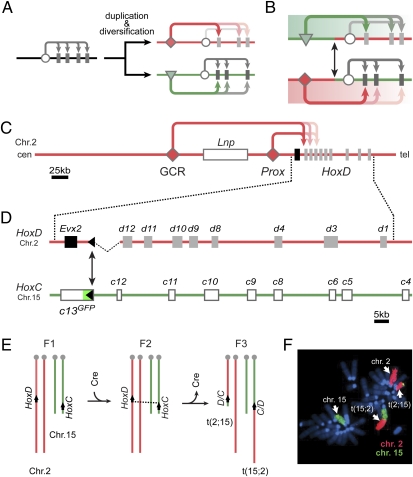Fig. 1.
Functional diversification of vertebrate paralogous gene clusters via the evolution of specific global regulations. (A) After duplication of a gene cluster, which was structurally constrained by an ancestral regulatory module (circles), functional specializations of twin clusters occurred through the emergence of remote global regulatory controls (red and green arrows). (B) The conservative exchange of such regulatory landscapes in vivo reveals the respective importance of regulatory versus structural evolution of the gene clusters in the acquisition of vertebrate-related innovations. (C) On chromosome 2 (Chr. 2), multiple global enhancer sequences (e.g., GCR and Prox) drive the expression of several posterior Hoxd genes in the distal limb bud. This large region, located centromeric to the HoxD cluster, is referred to as a regulatory landscape (16). (D) Our PANTHERE (PAN-Genomic Translocation for Heterologous Enhancer RE-shuffling) strategy whereby any regulatory landscape containing a loxP site can be associated to a heterologous target locus. Here, a balanced translocation between chromosomes 2 (Chr. 2) and 15 (Chr. 15) exchanges the centromeric landscapes between the murine HoxD and HoxC loci, bringing the latter under control of the HoxD digit-regulatory landscape. (E) Crossing scheme of the PANTHERE approach. Transgenic Cre-expression induces recombination events between nonhomologous chromosomes harboring single loxP sites at the 5′ extremities of the HoxD and HoxC clusters. (F) Metaphase-spread nuclei of cells obtained from a mouse carrying the translocation, stained for chromosomes 2 (Chr. 2, red) and 15 (Chr. 15, green), showing the presence of both translocated chromosomes t(2;15) and t(15;2).

